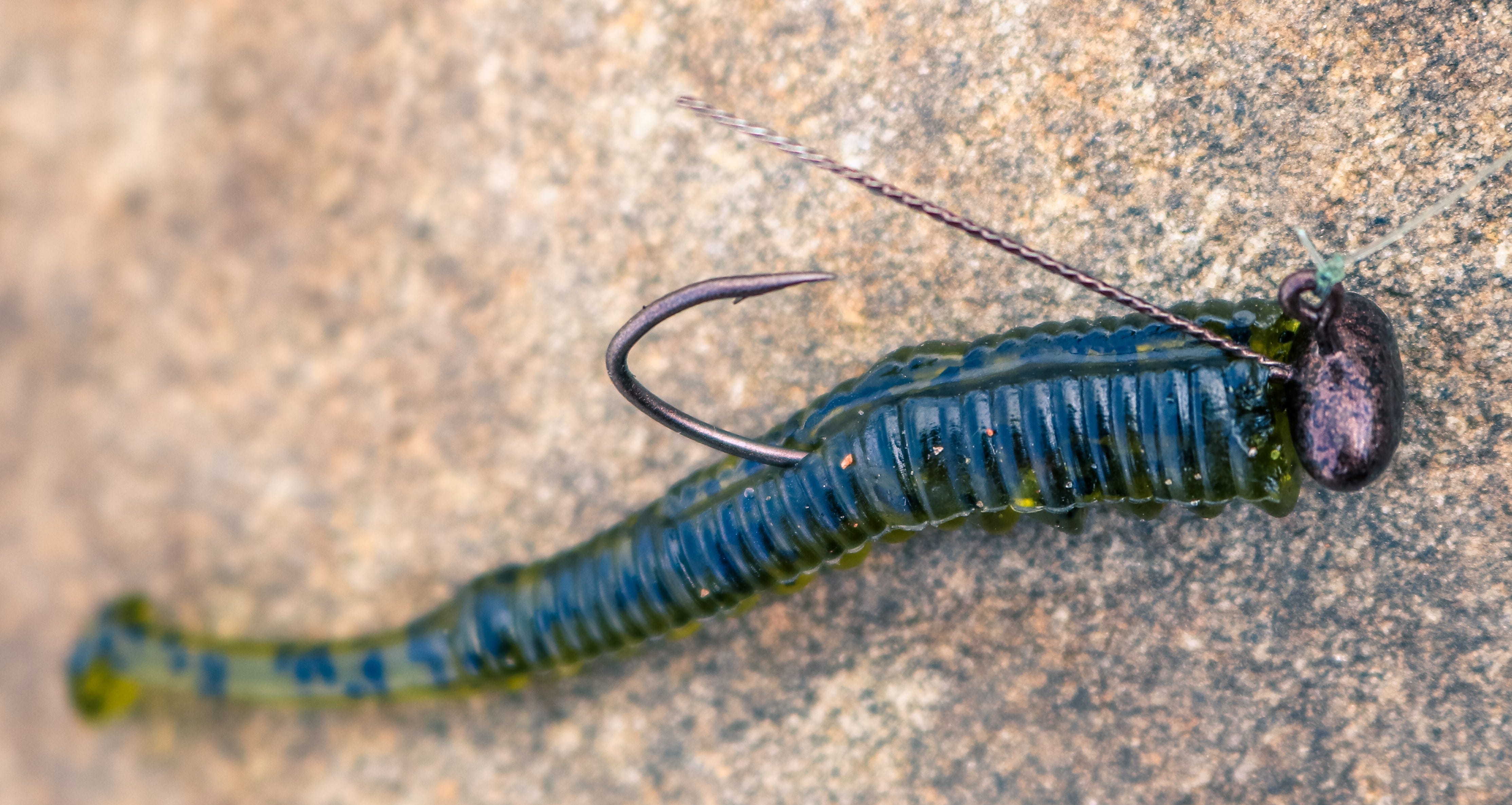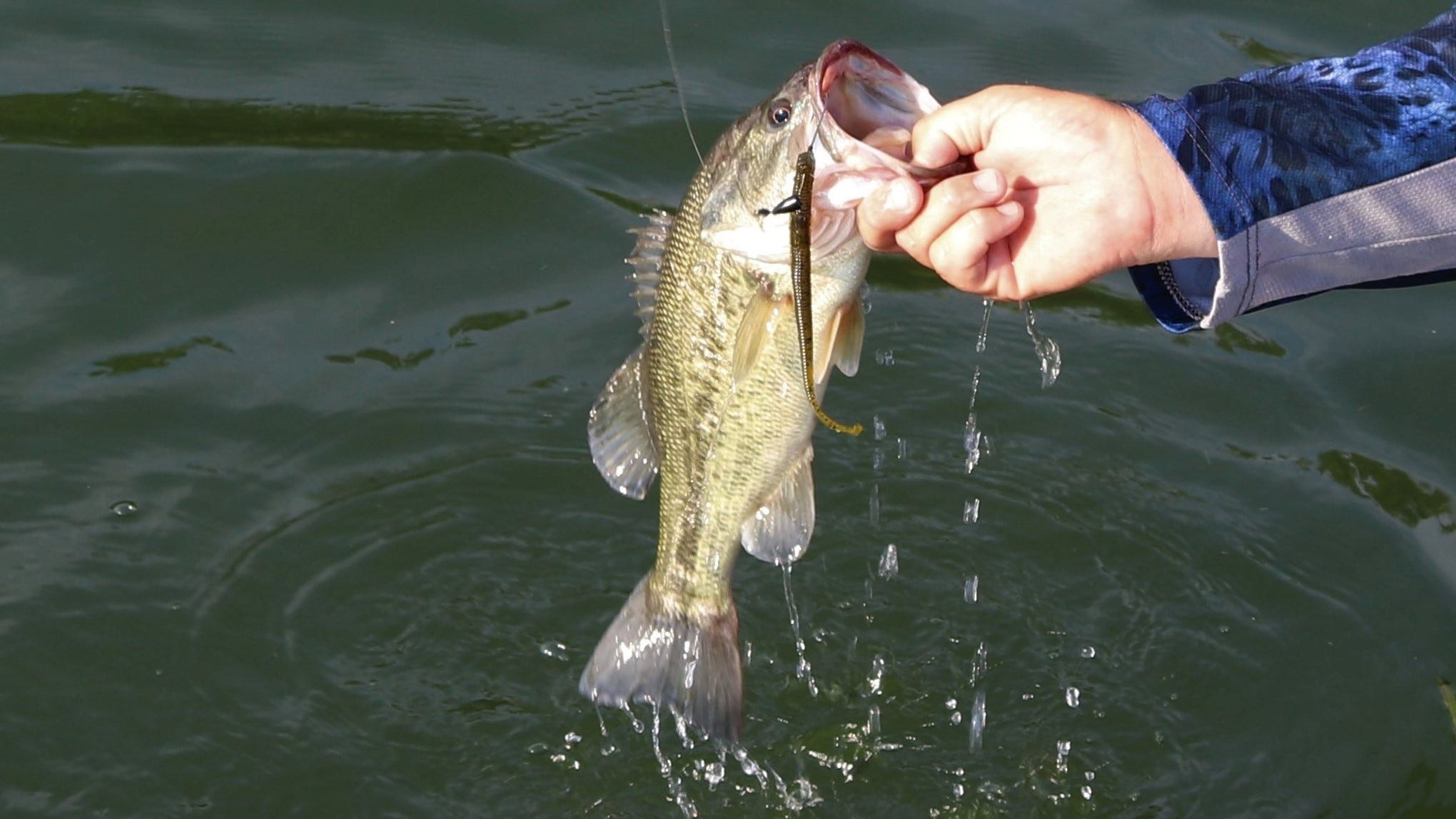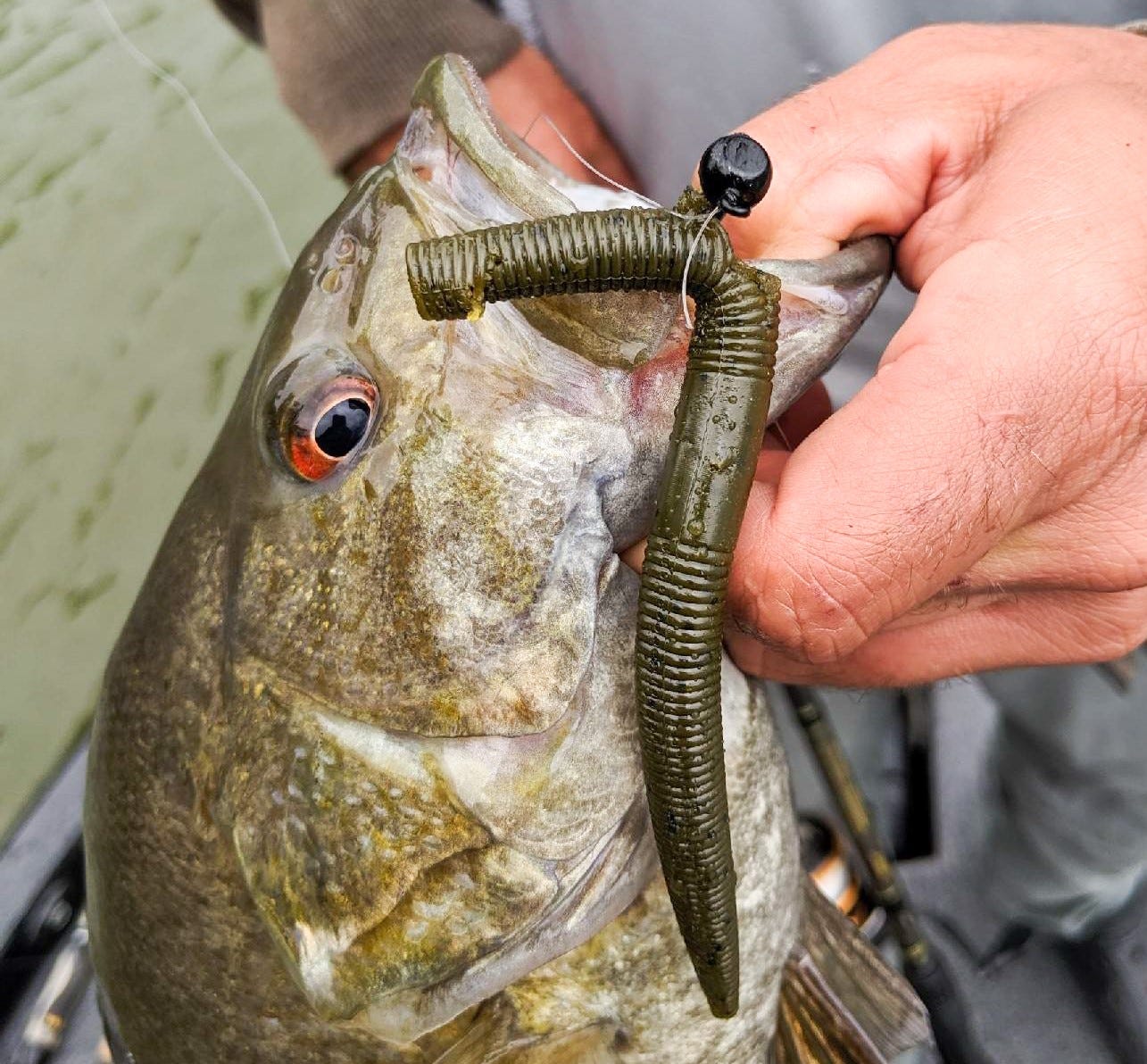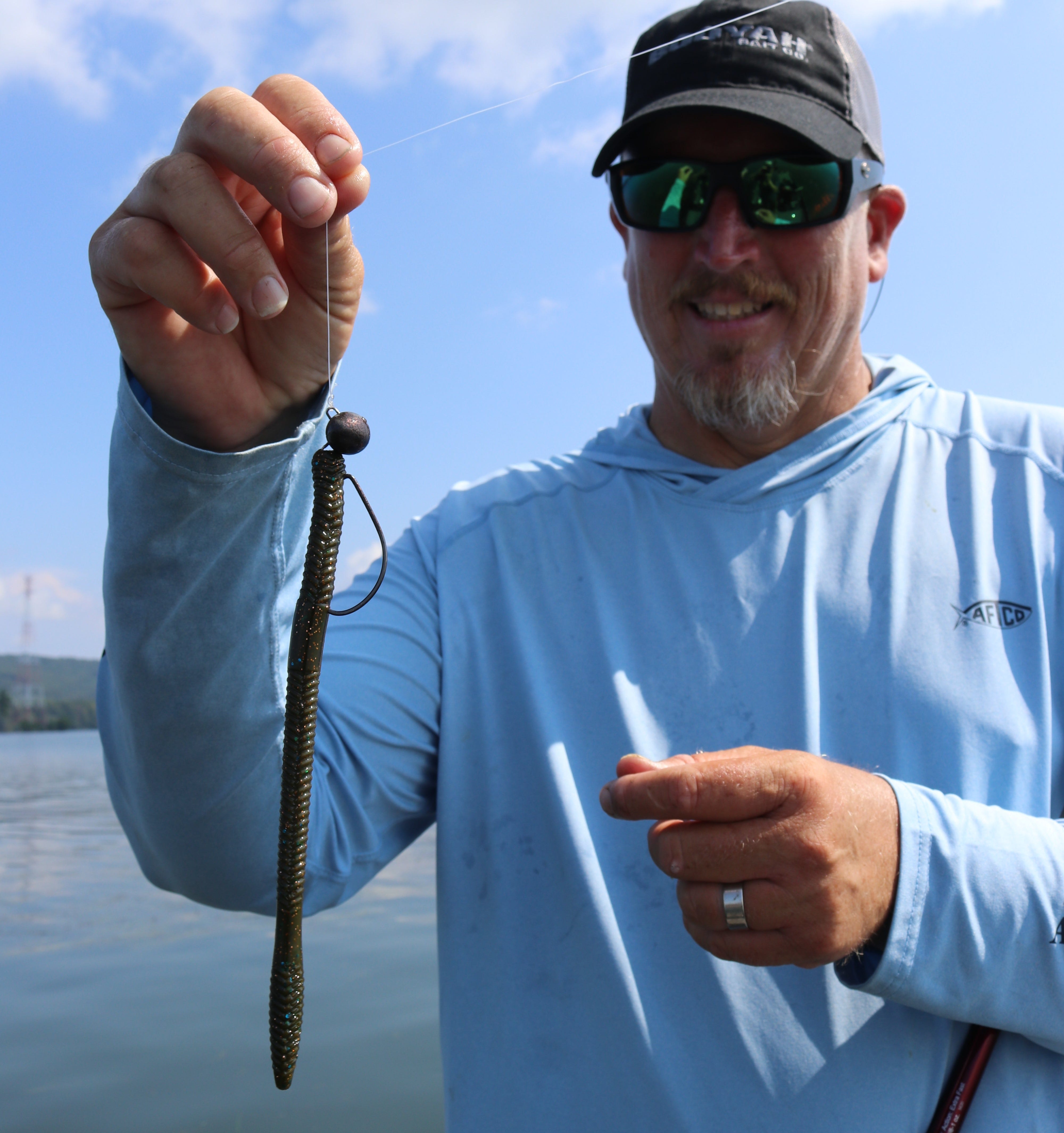- Aug 16, 2022
Top Plastic Worm Presentations for Summer Bass Fishing
Don’t overlook the diversity and fish catching abilities of a plastic worm this time of year. We’ll examine top rigging options for summer.
Plastic worm fishing seldom gets a lot of attention in articles and videos about summer bass fishing. Other approaches are newer and flashier, and seemingly would provide an edge. Plastic worm fishing produces bass in a huge range of water types and conditions, though, and summer is prime time to put a worm to work in your favorite bass waters.
Plastic worms can go in places where many other bass fishing lures cannot, and the slender profile makes even a large worm look like easy prey for a bass. Worms are also less expensive than many other types of lures, and they are generally easy to fish. Let’s look at some of the best rigging options and presentations for summer plastic worm fishing.
Plastic Worm Options


For starters it’s worth nothing that plastic worms for bass fishing encompass a much broader group of lures than once was the case. Worms range in length from only a few inches to nearly a foot and can be narrow and straight or somewhat bulky and contoured, and they come with many styles of tails.
Some worms, like the YUM Finesse Worm and Gene Larew Tattle Tail Worm, offer narrow profiles and subtle action. Others, like the 10.5-inch YUM Mighty Worm, are much larger, while still others, like the YUM Ribbontail, offer far more movement as they move through the water.
Stick baits, like a YUM Dinger, are sometimes categorized as worms and sometimes not. Because of the elongated configuration and because they are often fished like other worms, we’re including them in this discussion. The Dinger family includes four sizes of classic Dinger that range from 3 to 6 inches, plus Ned Dingers, Thump’n Dingers and Swim’n Dingers.
Texas & Carolina Rigs


We’ll begin with the classic Texas rig and Carolina rig because they seem to be the least discussed and are arguably the most important during summer because of their weedlessness and sheer effectiveness in a range of settings.
Both use the same hook rigging, with a worm hook (usually offset) pushed through the top of the head and angled out the underside, just below the entry point, and then turned and reinserted into the worm’s body to cover the hook tip. Most anglers push the hook all the way through and “skin hook” it on top, as opposed to leaving it fully buried in the worm.
For a Texas rig, a bullet weight slides on the line above the hook, so it rests on the worm’s head. A Carolina rig separates the hook and weight with a leader section that is tied to a swivel, and the weight, which is typically bullet- or egg-shaped, slides on the main line in front of the swivel (and usually a bead, to protect the knot).
Texas-rigged worms are exceptionally diverse, and summer applications range from working edges of shallow grassy hump with a small worm like a Tattle Tail Worm and a 1/8-ounce worm weight to punching mats with a 6-inch YUM Dinger and more than an ounce of weight. Not to be overlooked, though, is the classic application of Texas rigging a Ribbontail Worm and hopping it down slopes or working it through brush top humps and points. Classic Texas rigging is especially productive on summer nights!
A Carolina rig is the perfect tool for methodically working structure to find fish during the summer. The uninhibited movement of the worm just above the bottom appeals to bass that aren’t necessarily in an active feeding mode, and the approach is equally effective working the shallow end of a point in only a few feet of water or dragging across a hump, saddle or roadbed 20 feet down.
Working a Carolina rig is as elementary as it gets. Make a long cast across the structure or toward the bank. Let the rig sink until it hits bottom. Sweep the rod slowly sideways to drag the bait, moving the bait only with the rod and using the reel to take up line and keep the line tight between steady repeated sweeps.
Wacky Rig Options
Wacky rigging a plastic worm, in its most basic form, involves hooking the worm once, through the middle with an exposed hook point, casting to a spot, and letting the worm fall through the water column. Most worms undulate irresistibly as they sink, and most hits come on the fall. It’s an exceptionally good way to prompt strikes when cast to specific pieces of cover and other high-percentage fish holding locations.
Popular and highly effective wacky rig variations include a flick shake rig, which uses a special weighted hook, and neko rig, which uses a nail weight to alter the fall is typically hooked off-center. The weighted variations allow you to work deeper and do a bit more searching because they fall faster through the water column. A good alternative for wacky rigging in rivers that have significant current is to add a bullet weight to the line.
When fish hold close to targets, the most efficient way to fish a wacky rig often is to cast close to the target and let the bait sink, and then reel back and cast again if nothing hits it before it reaches bottom. For weighted rigs and fish that might be a more widespread, a better approach, after the worm hits bottom, is to repeatedly lift the rod tip a couple of feet and allow the worm to fall back toward the bottom.
Worms with simple tapering tails, like Finesse Worms and YUM Dingers generally work best for wacky presentations because of the way they fall. Size and thickness of profile are the primary factors that point toward the best specific worm.
Most wacky rig fishing is done with spinning tackle, light line and small-diameter hooks. However, 5-inch Dingers and Mighty Worms lend themselves to beefed up versions of the same basic approach, often with baitcasting tackle.
Jighead Worm Rigging


Jighead worms come in many forms to fit a host of situation, with some designed to swim like a grub and some fairly large options. However, the two most popular applications, Ned rigging and shaky head fishing, are finesse presentations that excel when things get tough late in the summer.
The Ned rig, named for longtime outdoor writer Ned Kehde who developed this finesse technique decades ago for fishing heavily pressured waters in the Midwest, uses lightweight mushroom-style jigheads and extra-small soft-plastic baits. A 3-inch Dinger was one of Kehde’s go to baits years ago, and still works well. However, Ned Dingers are slightly smaller, flattened at the end to fit snugly on the jighead and designed with an air pocket that holds the tail end of the bait higher in the water column. The Gene Larew Inch Worm, which can be shortened to measured lengths, and Pig Head offer another excellent Ned rigging option.
Folks fish Ned rigs with a variety of rod movements, including drags, jiggles, and lifts. Common denominators for most successful presentation are “slow” and “subtle.” A Ned rigged plastic worm will coax bites from bass that won’t commit to most presentations.
Shaky heads, usually rigged with the hook point turned back into the worm, also deliver a measure of finesse – just less extreme than with a Ned rig. A small stand-up head, like a War Eagle Jig Head Worm head, matched with a Tattle Tail Worm or YUM Finesse Worm is ideal for this presentation.
Again, slow and subtle are key words. Shaky heads are usually worked with very short drags and pauses that keep the jighead in contact with the bottom and with slight rod tip jiggles that cause the head to rock and worm to wiggle without moving the rig horizontally.
Both popular jighead presentations are best executed with light to medium light spinning tackle and light line. Eight-pound braid with a 6- or 8-pound-test fluorocarbon leader works nicely for both techniques.
Alternative Rigs


- Hard Head Worm – The Biffle Hard Head isn’t only got Biffle Bugs. Tennessee River guide Jimmy Mason likes to rig a Mighty Worm on this swiveling head to coax fussy ledge fish into biting. Slithering along the bottom, it produces lots of fish that have seen too many crankbaits.
- Weightless Texas Rig – Hooked just like a Texas rig, but with no weight on the line, this rig can be cast near cover and allowed to just sink (very popular with Dingers) or worked with slow gentle twitches, so it slithers a foot or two beneath the surface and falls slowly between twitches. Great for working through shallow vegetation.
- Stoopid Rig – Developed and named by fishing industry legend TJ Stallings, the stooped rig uses red circle hook with a Tru-Turn HitchHiker on the bend of the hook and the worm screwed onto the Hitchhiker. He chose the name because there’s no wrong way to fish a worm rigged this way. and the fish tend to hook themselves on the circle hook.
- Dropshot Rig – Maybe it’s a stretch to call a dropshot an alternative rig for summer fishing. It works spectacularly for summer fishing, especially in deep, clear lakes. We’ll make that another discussion for another time, though!



